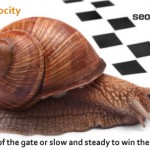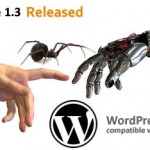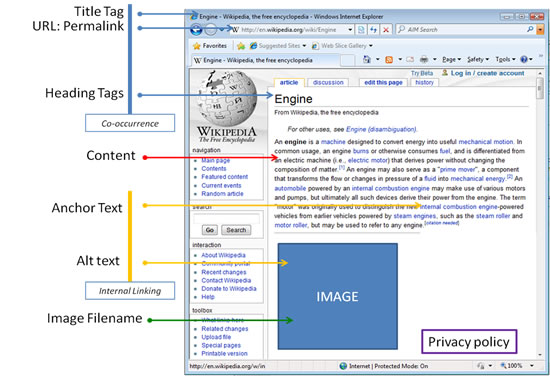On-page optimizations
On Page SEO requires a specific type of tact. Elements of each page, both visible and embedded in the code, can help search engines understand the content of the page, and how that page relates to the theme of a website.
The opportunities for search engines to understand a page
Title tag
The title tag of a page provides search engines with useful information about the content of the page. Title tags should be unique from all title tags within the website. Relevance is based on semantics in an elliptical fashion. Hallmark: Simple and succinct.
URL: Permalink
The structure of the URL should follow the guidelines listed in Subject II: URLs and redirects.
Heading tags
Heading Tags Provide search engines with useful information about how a document is structured. There are several types of heading tags depending on the construction of web page, and the content management system/shopping cart serving the web page –when applicable. The most important of all heading tags is the <h1> tag, which is positioned near the top of the page.
Co-occurrence: Best Practice
The title tag, URL:Permalink, and Heading tags all should have the same semantic set of keywords.
Content
Content is important to search engines. In general, a minimum of 400 words of unique content is necessary to give a page any significant chance at ranking in the search engine results pages. Content should be keyword dense, to 3-5%, and should reinforce the title tag, URL:Permalink, and Heading tags on the page.
Internal Anchor text
Links pointing to a page gives search engines an opportunity to better understanding of the reputation for that page. The anchor text, or the text through which the hyperlink is created, is the mode for understanding that reputation.
Internal Alt text
Alt text is the Anchor text of an image. Using a brief and descriptive alt text for images throughout a website helps search engines know more about the content within. All images should have relevant anchor text, even the company logo.
Internal linking: Best Practices
The links created on a page should support the co-occurrence for the specified target page by use of the anchor text or alt text. The more internal links created within a website, the easier it is for search engines to reach more content within your website. Also, building more links will improve the reputation for any one page within a website. The number of potential links on any one web page is dependent upon the amount of content on that page. Less than 50 links is considered Best Practice.
Any link that is created should target the canonical of a page to prevent 404s and consolidate reputation.
Image filename
Making each page as unique as possible is important. When an image is pulled onto a webpage, either locally or through parallelization, it is better to have a distinct image filename. Doing so further supports the uniqueness of the page.
Privacy policy
Google’s goal is to provide users with trustworthy websites. A privacy policy is required any time a website collects information, and is an indicator of trust for the search engines. A footer link to the privacy policy is considered best practice.










Good post. I like the way that you presented the content. Very easy to understand. Very informative. Cheers.
Kudos to Nick Hoffman on this one, he allowed one of our internal documents to leak out for a future training module…
I noticed Wikipedia doesn’t use image ALT-text.
What they do is build a page that includes an image, for each image they build another new page, just for that image. Then they include the ALT-text in the image on the 2nd page.
If you use the same Wikipedia “Engine” page (like in the screenshot of this post), have a look at the animated .gif image on the right side of the screen. Click on the animated .gif, & the link will take you to another page just for that image only.
Now take that animated .gif page URL in your browser address bar, & check the PR (pagerank).
That animated .gif page has a PR-5, wow…
Here is the URL to check the PR:
http://en.wikipedia.org/wiki/File:4-Stroke-Engine.gif
Hey SlimJim:
That explains one of the 5 pages Wikipedia has corresponding to each page. One for sitemaps, one for images…
Now, what are those other 3 per silo/page?
“Now, what are those other 3 per silo/page?”
LOL, looks like keyword stuffing to me. ;)
They include all the page/post revisions in those tabs, at the top of the “Engine” page.
I recived Lot’s of knowledge form Your Site so i like this site and i will do agian
best tips Seo.I am looking like this.
so thanks for sharing and keep updating….